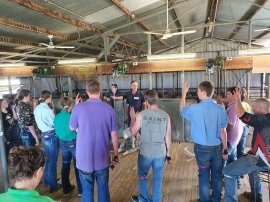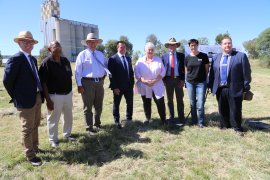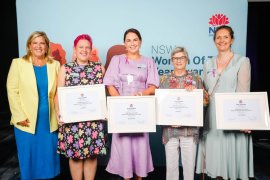-
Featured Items
-
Featured Resources
 Funding & Grants
Don't miss out on funding opportunities. Stay informed with our up to date online listings and email notifications.
Read More
Funding & Grants
Don't miss out on funding opportunities. Stay informed with our up to date online listings and email notifications.
Read More
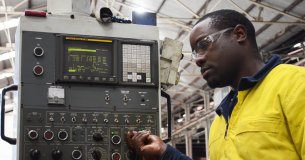 Skilled Migration
Our services help both applicants and employers, to learn more, develop plans, submit applications, and settle in.
Read More
Skilled Migration
Our services help both applicants and employers, to learn more, develop plans, submit applications, and settle in.
Read More
 Research and Analysis
Good research and analysis makes the case. How can our resources and services help your project or application?
Read More
Research and Analysis
Good research and analysis makes the case. How can our resources and services help your project or application?
Read More
 Information & Data Resources
With resources like REMPLAN, Regional Knowledge Base, and decades of data, discover how we can help your project.
Read More
Information & Data Resources
With resources like REMPLAN, Regional Knowledge Base, and decades of data, discover how we can help your project.
Read More
-
Stay InformedSubscribe to one or more of our regular email subscriptions, to be kept up to date on news and funding opportunities for the region
-
-
Our Region
- Our Region
- Regional Plan
- Regional Data
- Current Regional Issues
- Population Migration Analysis for 2016-21
- Job Vacancies Continue at All-Time High
- National Debt - What it Means for Our Economy?
- The True Value of Home Solar
- The Economic Impacts of Local Government Amalgamations
- State of the Regions Report 2014-15
- Antifragility - A different take on regional economic development
- Biohubs - Collaborative Waste Management
- Attracting New Residents
- Socio-Economic Impacts of the Murray Darling Basin Plan
- Murray Darling Basin Water Recovery
- Growing Businesses
- The Northern Inland Economy
- Geographical Overview
- Major Industry Sections
- Our Services
- Grants and Funding
-
Skilled Migration
- Skilled Migration
- Skilled Employer Sponsored Regional Visa
- Skilled Work Regional Visa (subclass 491)
- Temporary Seasonal Workers
- Designated Area Migration Agreement (DAMA)
- Helpful Information for Visa Holders
- Information for Employers
- Case Studies
- Payment Details
- Advice & Further Information
- Contact Details
- News & Events
-
Our Projects
- Our Projects
- Current Projects
- Skilled Migration
- Wool Works - Wool Training Schools
- Metal Works - Welding and Fabrication Schools
- Come On Inland
- Stories of Resilience
- Alt Brothers Beekeeping - Glen Innes
- Carelle's Toy Store - Glen Innes
- Greenhill Orchards - Arding
- Gwydir Meats - Warialda
- Kaputar Motors - Narrabri
- Moonbi General Store - Moonbi
- Sandstock - Tingha
- Sherelle Fashions - Tenterfield
- Sleepy Merino - Inverell
- Tenterfield Chamber of Toursim, Industry and Business - Tenterfeild
- The Welders Dog - Armidale
- Walcha Veterinary Supplies - Walcha
- AGCAP - Agribusiness Careers & Professions
- Northern Inland Regional Investment Profile
- Past Projects
- Digital Economy Strategy
- Business Growth Project
- Go Digital
- How to Start an Online Business
- Create Your Website Using Squarespace
- How to Edit Your Squarespace Site - Part 1
- How to Edit Your Squarespace Site Part 2
- Add a Shop to Your Squarespace Site
- Start a Blog and Find out What Customers are Searching
- 14 Tips For a Better Blog Post
- Which Social Media Platforms are Best for Your Business
- How to Use Facebook Effectively For Your Business – Part 1
- How to Use Facebook Effectively For Your Business – Part 2
- Instagram Tips for Business
- Catching Up, More Instagram & Dealing with Haters
- Getting Started with Twitter for Business
- Social Media Scheduling Tools
- How to Start an Etsy Shop – Part 1 – Research
- How to Start an Etsy Shop – Part 2 – Signup
- Online Security for Your Business
- Product Photography and Website Images: Your Guide
- 5 Tips to Improve your Productivity in your Business
- Best Online Business Resources
- How to Improve Your Communication Skills and Win More Clients
- NBN Coordinator
- Putting Power Back in the Regions
- Road Freight Study
- Town Audit Benchmarks
- Food and Wine
- Youth Survey
- Digital TV Switchover Assistance
- Northern Inland Transport Guide
- Live.Train.Work
- Northern Inland Innovation Awards
- Northern Inland Innovation Awards - 2017
- Northern Inland Innovation Awards - 2016
- Northern Inland Innovation Awards - 2015
- Northern Inland Innovation Awards - 2014
- Northern Inland Innovation Awards - 2013
- Northern Inland Innovation Awards - 2012
- Norther Inland Innovation Awards - 2011
- Prime Super Northern Inland Innovation Awards - 2010
- Prime Super Northern Inland Innovation Awards - 2009
- Northern Inland Innovation Awards - 2007
- Northern Lights Project
- NBN Smart Home
- Murray Darling Basin
- Moree Plains Business Workshops
- Namoi Investment Prospectus
- Industrial Land
- Bioenergy and Local Electricity Retailing
- Northern Inland Business Energy Assessment
- Skills for the Future
- Impacts of COVID-19 on Businesses
- Past Projects of NIRDB
- Aboriginal Employment and Enterprise in the Gunnedah Region
- Art as an Industry
- Aviation Survey
- Farm Forestry - Northern Inland Forestry Investment Group
- New England North West Film Strategy
- Northern Inland Excellence in Business Awards
- Food and Wine 2003 - 2008
- Prime Super Northern Inland Innovation Awards 2009
- Regional Business Networking Program
- Regional Leadership Course 2008
- Viticulture Strategy 2002-2003
- About Us
- Contact Us
- Other Resources
- Privacy and Legal
- Search
Back to Newsletters
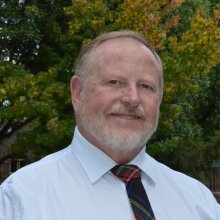

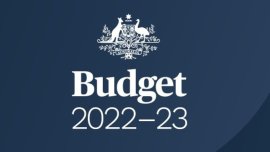
March 2022 Newsletter
Thursday 31st of March 2022
In this Issue
- Welcome from the Chair
- Our Shearing School Upskills Tamworth Students
- Report Highlights Strengths and Opportunities of Regional Areas
- March Round of 491 ROI’s Close Today
- $194M Funding for Moree Special Activation Precinct
- Support for Regional Australia in Federal Budget
- Walcha Local named Premier’s Woman of The Year
- Featured Grants and Funding Opportunities
Welcome from the Chair

Dear Northern Inlanders,
It’s hard to believe the first quarter of 2022 is already over, and preparations are underway for the 2022-23 financial year. Many of us are facing tough times financially, with the cost of living on the rise. It was pleasing to see support in the Australian Government’s budget to help what is yet another blow for many. We must also set our minds to the future and invest in our regions to provide much-needed infrastructure to support our region’s growth.
A crucial part of helping our region prosper in the future is to take advantage of our unique strengths and address existing infrastructure barriers. The recently released Regional Strengths and Infrastructure Gaps report by Infrastructure Australia has taken a significant step in identifying the strengths and opportunities for our region. As noted in the report, infrastructure is not just construction, such as roads and bridges, but also the infrastructure for knowledge attainment. We constantly hear from employers in many industries that they face skill shortages and cannot fill vacant jobs. It is time that we took some positive steps to provide the teachers and training facilities for our communities to gain the skills needed in our region, rather than moving away or travelling long hours.
There are brilliant ideas and enthusiasm in our communities, and it is pleasing to see when they are recognised at a State or National level. So I was happy to hear that Anna Barwick from Walcha received the NSW Premier’s Woman of the Year award for her work to increase access to pharmacy services for people in rural communities. Our congratulations also go out to the other Northern Inlanders, Jody Ekert and Laura Carter, who were finalists at the NSW Women of the Year Awards for their contributions to their communities.
Regards,
Russell Stewart
Chair
Our Shearing School Upskills Tamworth Students
This month, a shearing shed became a classroom for 16 students in years 9 to 11 from Tamworth and Peel High Schools, with another Wool Works Shearing School held at Trelawney Station. Teenagers are not always aware of the wool industry's rewarding, well-paying jobs and training options. Our shearing schools provide them with an introduction to the wool industry and practical training in shearing and wool handling.
The format of the shearing schools is very hands-on to increase engagement with the students, and industry feedback has been positive. The shearing school is not just an escape from school for a few days as students are really put to work. Over 100 sheep, kindly arranged by Thomas Foods International, were shorn during the week.
Rural employers are crying out for skilled workers, and there is a real shortage of shearers and rural workers generally. Our shearing schools aim to address these skill shortages by providing students with skills that can genuinely translate to employment. Local young people keen to work in our agricultural sector need a broad skill-set to be valuable contributors to local farm businesses. Our shearing schools are playing an important role in demonstrating that. Encouraging students to seek further shearing training will also be crucial to addressing the skills shortage in the wool industry.
Most previous shearing schools have been held at Glen Innes. This Tamworth-based school was an excellent opportunity to broaden young people's agricultural skills and experience in the Tamworth and North-West side of our region. We were fortunate to utilise the facilities at the Tamworth Local Aboriginal Land Council’s Trelawney Station, near Somerton. It is an ideal venue with fantastic accommodation and catering facilities.
A big part of the success of our shearing schools is due to the collaborative effort that makes them unique. For this shearing school we had valued support from TAFE NSW, Australian Wool Innovation and the Tamworth Local Aboriginal Land Council, along with grant funding from the NSW Government’s Stronger Country Communities Fund.
We also had the expertise and experience of veteran shearers and wool handlers providing the training. Our trainers were Leo Fittler, Matt Cumming, Ross Thompson and Kim Jenkins, who all have many years of experience in the wool industry, shearing, wool handling and training. They were able to convey a great deal in a matter of days due to the practical approaches taken in our shearing schools.
More short shearing schools are planned throughout the region in 2022, and interested high schools can contact our office by email at rdani@rdani.org.au.
Report Highlights Strengths and Opportunities of Regional Areas
Along with 47 other Regional Development Australia Committees around Australia, we partnered with Infrastructure Australia to develop the Regional Strengths and Infrastructure Gaps report. This report provides a lens to highlight the opportunities in our regions and prioritise investment in Regional Australia. It highlights opportunities to support the regionalisation trend that took hold during the pandemic and identifies the strengths and opportunities for each RDA region.
In addition to Infrastructure Australia’s consultation with RDAs, key regional stakeholders, including businesses, peak bodies and industry groups, were engaged to help create a picture of each area’s diverse assets, growth industries and infrastructure requirements. With the report's debut, Infrastructure Australia aims to increase the focus on the needs of Regional Australia.
“This is the first time a report of this magnitude has been conducted solely on Regional Australia that localises each area’s strengths and opportunities. It provides a foundation of data, knowledge and community perceptions to support future infrastructure planning, decision-making and network governance across the country.” said Infrastructure Australia Chair, Col Murray. “Our consultation highlighted that many regions are eager to capitalise on new opportunities and industries. However, they need to have robust, reliable and resilient infrastructure networks to tap into this growth. Governments at all levels, businesses and communities themselves, have acknowledged the need to address these challenges for many years, but too often they work in isolation.”
“With the debut of the Regional Strengths and Infrastructure Gaps, we aim to focus the future effort on mutually acknowledged needs, leveraging the assets of industry and the community, alongside government. However, this report is the beginning, rather than the end of the journey. We hope to encourage all stakeholders to come forward with solutions for local challenges and seize opportunities for growth, innovation and investment,” Mr Murray said.
In 2019/2020, there was a 200% growth in Australia’s regional areas, a regionalisation trend that has continued, with the first quarter of 2021 being the largest internal migration on record.
“The significant upswing in regionalisation – further accelerated by the pandemic – has compounded pressure on already stretched regional infrastructure assets and networks.” said Chief Executive of Infrastructure Australia, Romilly Madew. “By drawing out commonalities where they exist, we are aiming to improve information sharing and enable a coordinated, forward-looking view of the challenges and opportunities in Regional Australia. We hope communities embrace the opportunities highlighted in this report and that it becomes a turning point for greater collaboration amongst stakeholders,” Ms Madew said.
The information on the Northern Inland, found in the report for New South Wales, highlights the diversity of our region’s natural resources and our ability to collaborate and leverage expertise and research to support industry growth. It identifies agriculture, forestry and fishing, energy and the knowledge sector as our three key regional growth industries. The report also acknowledges that our region's three top infrastructure gaps are water security, access to further education and skills training, and telecommunications.
An interactive map is also available, which allows dynamic navigation of the report data by region, key assets, growth industries or infrastructure gaps.
The report is a starting point for discussion between all parties to inform further planning, policy and investment solutions. Further consultation is being encouraged with submissions open until 29 April 2022.
March Round of 491 ROI’s Close Today

In March, the NSW Government has been running its third round of Registrations of Interest for 491 Visa nomination, which closes today. Interested applicants must receive an invitation to apply from the NSW Government through this process before submitting a full application for nomination.
We look forward to receiving full applications from those who were invited to apply from the NSW Government in this round. Be sure to follow the steps we have provided on our website on how to apply for a 491 Visa to ensure that you provide all the required information with your application. We also have a well-established Skilled Migrant Settlement Support Group on Facebook for skilled migrants moving to our region. In this group, you can find assistance from other Skilled Migrants to find accommodation and answer any general questions about the region you may have.
As with previous rounds, if you submitted a registration of interest and have not received an invitation by ten days after the close of the round, you should assume you will not receive an invitation from that round. While it can be disappointing to not receive an invitation to apply, please keep in mind that the NSW Government issues invitations to apply, and we are not involved in this invitation process. We can only respond to enquiries about this first step in the 491 Visa process that are general in nature. Further information about how to register your interest with the NSW Government and the online form is available on the NSW Government’s website. We also recommend reading through their frequently asked questions about the ROI process which has information for 190 and 491 Visas.
Although we enjoy meeting Skilled Migrants who move to our region, our office is currently closed to visitors for the safety of our staff and their families due to the current spread of COVID. While we appreciate that it can sometimes feel easier to talk face-to-face, we cannot make exceptions. Our Skilled Migration Officer, Gary Fry will be available to assist where possible for those looking to apply to the Northern Inland by phone on 6771 0700 or by email at migration@rdani.org.au
$194M Funding for Moree Special Activation Precinct
Moree Plains Shire Council has welcomed the NSW Government’s $194 million infrastructure investment for the Moree Special Activation Precinct.
Special Activation Precincts are a new way of planning and developing industrial and commercial infrastructure in targeted areas of regional NSW. By providing the right planning framework, approvals and infrastructure are put into place quickly and efficiently, allowing for the attraction of businesses, industry and jobs to the area.
This funding will support construction of the first tranche of infrastructure works and utilities for Moree’s Special Activation Precinct, including new and upgraded roads, telecommunications, water and wastewater infrastructure, electricity and stormwater drainage.
“The NSW Government’s $194 million commitment represents one of the single largest investments in the history of our Shire, and I wish to thank the Deputy Premier Paul Toole, our local member, Mr Marshall MP, our Federal member, Mr Coulton MP, and the NSW Government for their vision and steadfast support for our Shire and broader Region,” said Mayor of the Moree Plains, Cr Mark Johnson. “This investment will mean transformational growth for our community for generations to come. The precinct will see enormous benefits flowing through to our Shire – it will attract new industries to our region, provide employment opportunities all year round, and help us retain our young people.”
“This announcement is the culmination of five years of work by Council staff and NSW Government colleagues. I pay credit to our staff, Councillors, the NSW Government, industry representatives and our community members who have been part of this journey and have helped develop and shape this project for the Moree Plains. I would also like to acknowledge the Moree Local Aboriginal Land Council for their collaboration and support.” said Acting General Manager Scot MacDonald.
The Moree Special Activation Precinct will leverage the region’s strong agricultural economy and natural resources to develop value-add industries in food processing, horticulture and renewable energy. Freight and logistics will also play a key role in moving produce and goods made in Moree and the Northern Inland around Australia and overseas, thanks to the Inland Rail traversing the Moree Plains Shire.
“With most of our high-quality produce leaving the Shire untransformed, there are huge value-adding opportunities to diversify our economy and maximise benefits for our community. The Moree Special Activation Precinct is a long-term partnership with NSW Government that has the capacity to generate up to 4,000 jobs over the next 40 years,” said Executive Manager Regional Activation Mark Connolly. “The Moree Special Activation Precinct will boast direct road, rail and air connections located in the heart of the most productive broadacre region in Australia, providing producers and industry with reliable and efficient links to local and international markets, and supporting the development of new and expanded intermodal facilities”.
The NSW Government will now work on the design and delivery of the precinct, including the delivery plan and procurement of construction services for the stage one infrastructure work. The final Moree Special Activation Precinct master plan was also released and is available on the NSW Department of Planning and Environment’s website.
Support for Regional Australia in Federal Budget

The Australian Government’s Budget was handed down by Treasurer Josh Frydenberg this week, focusing on providing cost of living relief, creating more jobs, guaranteeing essential services and keeping Australians safe.
The Australian Government is investing record amounts in infrastructure and regional development projects through the 2022-23 Budget as part of a plan for a stronger future, to make our nation wealthier and stronger, create tens of thousands of jobs and drive economic growth.
Cost of living relief
- One-off Cost of Living Tax Offset - From 1 July this year, more than 10 million individuals will receive a one-off $420 cost of living tax offset. As a result, eligible low- and middle-income earners will be up to $1,500 better off for a single income household, or $3,000 better off for dual income household.
- One-off Cost of Living Payment - To help Australians most in need the Government is providing a one-off, income-tax-exempt payment of $250 to 6 million eligible pensioners, welfare recipients, veterans and eligible concession card holders in April 2022.
- Temporary fuel excise relief - The Government will reduce fuel excise by 50 per cent for 6 months. This will see excise on petrol and diesel cut from 44.2 cents per litre to 22.1 cents per litre. The reduction in excise will flow through to lower petrol prices over the next two weeks, as petrol stations replenish their stocks.
Jobs
- The Government is transforming Australia’s manufacturing sector and building resilient supply chains with over $1 billion in new investment, building on the $1.5 billion Modern Manufacturing Strategy announced in the 2020-21 Budget.
- Committed $2.8 billion to support Australian apprenticeships, building on the $13.3 billion spent on apprenticeships and traineeships since 2013.
- The Government has committed $3.7 billion in Commonwealth funding for a new skills agreement, which has the capacity to deliver up to 800,000 additional training places for Australians.
- To develop the next generation of innovative Australian companies, this Budget includes $2.2 billion for a research commercialisation action plan (including $1.6 billion for a new economic accelerator) to bring industries and universities together.
Small Business
- Small businesses will have access to a new 20 per cent bonus deduction for eligible external training courses for upskilling employees.
- The Skills and Training Boost will apply to expenditure incurred from Budget night until 30 June 2024, providing $550 million in tax relief.
- The Government is also providing $1 billion for a new Technology Investment Boost to encourage small businesses to go digital.
- Small businesses will be able to deduct a bonus 20 per cent of the cost of expenses and depreciating assets that support digital uptake.
- Expenditure of up to $100,000 per year will be supported by this new measure, which applies from Budget night until 30 June 2023.
Essential Services
- The Government has allocated $6 billion for the COVID-19 Health response, which includes support for the Governments’ Winter Response Plan to prepare for the next wave of COVID 19 and influenza.
- $3.0 billion over five years for cheaper medicines to support a healthier Australia.
- $1.3 billion to support delivery of the next National Plan to End Violence against Women and Children 2022-32.
- $165.0 million for wellbeing programs and $104.2 million for health services to support veterans and families
Infrastructure
The Government has increased its 10 year transport infrastructure pipeline to a record $120 billion with an additional $17.9 billion committed to road, rail and community infrastructure projects supporting around 40,000 jobs. Including through its $8.9 billion National Water Grid Fund, the Government will provide a further $7.4 billion to improve Australia’s water security and open up new land for irrigation.
As well as projects in each state and territory, the Government is investing:
- $2.0 billion through the Regional Accelerator Program to drive growth and productivity in regional areas.
- $501.7 million for local councils to deliver priority road and community infrastructure projects across Australia.
- $2.0 billion in additional funding for the Northern Australia Infrastructure Facility, bringing total funding to $7.0 billion.
Inland Rail
The Government will continue to invest in the nation-building Inland Rail project, supporting jobs and delivering an economic boost in regional towns from Melbourne to Brisbane and beyond.
They will commit $3.1 billion for two new intermodal terminals and connecting infrastructure in Melbourne at Beveridge and Truganina, taking total Australian Government funding to intermodal terminals in Melbourne to $3.6 billion.
These terminals will help remove around 5,500 truck movements per day from metropolitan arterial roads in Melbourne, reducing congestion and emissions across the CBD, and improving safety. These investments will improve supply chain productivity and reliability while unlocking freight efficiencies across the broader national network, including the Inland Rail. They will better connect regional businesses and exporting industries with domestic and international markets.
Additional investments to bolster the construction of Inland Rail include:
- An additional $300.0 million through the Grade Separating Interfaces Program to fund new grade separations in New South Wales along the Inland Rail route; and
- $150.0 million to fund the construction of complementary infrastructure projects that will unlock the benefits of Inland Rail for regional economies.
Walcha Local named Premier’s Woman of The Year
Walcha local Anna Barwick has been named the 2022 NSW Premier’s Woman of the Year at the NSW Women of the Year Awards held in Sydney.
As a PhD student and practising pharmacist, Anna is particularly focused on rural health and women’s health. She started PharmOnline with the goal of connecting every household in Australia to accessible pharmacy services. PharmOnline clients include new parents, patients with disabilities/chronic diseases and people in geographically isolated areas that require assistance to manage and optimise safe medication use when required.
“Ms Barwick’s telehealth service has innovated how people access pharmacy services, ensuring vital care is at the fingertips of people right across the country, no matter where they live,” said NSW Premier Dominic Perrottet.
Minister for Women Bronnie Taylor said Ms Barwick’s achievements and commitment to uplifting the lives and health outcomes of regional women showed tremendous courage, perseverance, and dedication. “This prestigious award celebrates the nobility of character, commitment to change, and the strength to succeed, all attributes held by Anna,” Mrs Taylor said. “Her innovation and resilience in such challenging times demonstrate her vision for change and desire to achieve something greater for regional communities. This accolade is well deserved.”
“I am so humbled to receive this award and feel so proud and grateful to be recognised in this forum among women of such high calibre and esteem,” Ms Barwick said. “Today I celebrate all the women who helped me to achieve this, and I applaud every woman in NSW for their sacrifice, hard work and endurance to succeed and make a meaningful difference to improving the lives of their loved ones and communities.”
Also recognised as a finalist in the Regional Woman of the Year category, was Jody Ekert. Jody is a queer, neurodivergent, solo parent who is challenging stereotypes about regional living and creating a safe space for diverse identities in Tamworth. In 2021 Ms Ekert staged the first ever Mardi Gras event in Tamworth. She has also built awareness and support for queer people in regional NSW as a member of the Tamworth Pride Committee and as Volunteer Oceania Outreach Co-ordinator for Global Pride. Ms Ekert also founded Tamworth True, an online support and information group for her local community with more than 4,500 members. Ms Ekert is passionate about sharing her intersecting identities to demonstrate how unique and multi-faceted women are in regional NSW.
Laura Carter from Emmaville was also a finalist in the One to Watch category. This category of the awards recognises girls and young women aged seven to seventeen, who demonstrate a single act or ongoing acts of courage, strength, determination and/ or kindness to help and support those around them. Laura developed a wide range of wellbeing projects for her school, such as Female Empowerment Day and has won a grant for her community at Emmaville to gain access to free fitness equipment.
Featured Grants and Funding Opportunities
Below are some featured grants and funding opportunities from the multitude of open grants listed in the Grants and Funding Opportunities area of our website. Our website is updated weekly with new listings and updates and all are applicable to our region, so it is a great resource if you are looking for funding for a specific project.
You can also sign up to our Business and Infrastructure Funding Opportunities and the Community Grants and Award Programs newsletters through the simple form located on the left-hand side of our website: www.rdani.org.au, to receive monthly summaries of currently open grants.
Clubgrants Infrastructure Grants
Closes: 15th of April 2022
Value: $10,000 to $300,000
Run By: NSW Office of Responsible Gambling
The objective of the Clubgrants Category 3 Infrastructure Grants program is to fund the costs of construction, alteration, renovation, completion and fit-out of buildings and community infrastructure to deliver outcomes for disadvantaged NSW communities including regional, remote and drought-affected areas, culturally and linguistically diverse, disability and Aboriginal and Torres Strait Islander communities and communities affected by bushfires.
Eligible entities:
- Not-for-profit organisations that will be responsible for operating and/or maintaining the infrastructure.
- Schools - applicants must consider if and how the infrastructure project is accessible to the public outside school hours.
- Local councils - applicants are required to cash-match the funding amount requested.
There are four infrastructure streams currently open for applications:
- Community Infrastructure Stream ($10,000 to $200,000) - Supports community infrastructure such as a multipurpose community hub or a service for an eligible community group.
- Arts and Culture Stream ($50,000 to $200,000) - Supports arts and culture infrastructure such as museums, art galleries or cultural centres.
- Sport and Recreation Stream ($50,000 to $300,000)- Supports sport and recreation infrastructure such as sports centres, playgrounds and swimming pools.
- Disaster Readiness Stream ($10,000 to $200,000) - Supports disaster readiness infrastructure such as evacuation centres, capital equipment or a multipurpose community facility.
Aboriginal Affairs Cultural Grants Program
Closes: 13th of May 2022 - 5:00 pm - Assessed monthly while open
Value: $500 to $20,000
Run By: Aboriginal Affairs NSW
This program supports Aboriginal community organisations across NSW to celebrate Aboriginal culture and hold key cultural events and activities.
The following are examples of the types of activities that may be funded:
- Women’s or Men’s Gathering on Country
- delivery of a culture and wellbeing camp for Aboriginal youth
- creation of a digital installation showing Aboriginal history of the local community
- statewide music or cultural festival
- hosting a series of online workshops
- community celebration event
- cultural activities at a regional sporting event
Clean Technology Research, Development and Commercialisation Infrastructure Grants
Closes: 22nd of April 2022 - 5:00 pm
Value: Up to $10 Million
Run By: NSW Government Energy Saver
This initiative funds world-leading research, development and commercialisation infrastructure to help accelerate NSW’s shift to net zero emissions by 2050.
These grants will invest in initiatives that significantly reduce emissions in high-emitting and hard-to-abate industries across the state. They will support investment in infrastructure that:
- accelerates the research, development and commercialisation of clean technologies with high commercial potential
- enhances our ability to develop new innovative clean technologies
- promotes collaboration between industry, researchers and universities.
These grants are open to organisations that can demonstrate experience in developing and managing this type and scale of infrastructure. This could include industry or research organisations. Collaboration between organisations is encouraged.
The four types of infrastructure eligible for this grant are:
- new or upgraded major innovation infrastructure
- e-infrastructure to generate data
- physical infrastructure to store data
- other infrastructure that supports significant decarbonisation.
Alfresco Restart Rebate
Closes: 30th of June 2022 or until 5,000 registrations
Value: Up to $5,000
Run By: Service NSW
If you are a small or medium food and beverage business wanting to create or expand your outdoor dining area, you may be eligible for a rebate of up to $5,000 under the NSW Government’s Alfresco Restart package.
The rebate is available to the first 5,000 eligible small or medium food and beverage businesses that register.
Businesses must first register to confirm their eligibility and registrations will close when 5,000 businesses have successfully registered.
Businesses that have successfully registered can claim their rebate from April 2022 for expenses incurred from 14 October 2021 to 30 June 2022.
Regional Airports Program – Round 3
Closes: 17th of May 2022 - 5:00 pm
Value: $20,000 to $5 Million
Run By: Australian Government Department of Infrastructure, Transport, Regional Development and Communications
The objective of the program is to improve the safety and accessibility of airports or aerodromes in regional areas of Australia by assisting airport or aerodrome owners/operators to undertake essential works, promoting aviation safety and access for regional communities.
The intended outcomes of the program are to:
- improve the safety of aircraft, operators and passengers using regional airports or aerodromes.
- facilitate improved delivery of essential goods and services such as food supplies, health care and passenger air services.
- improve the connectivity of Australia’s regions to domestic and global market opportunities.
- meet the operational requirements of aeromedical and other emergency services in the region.
Related Pages







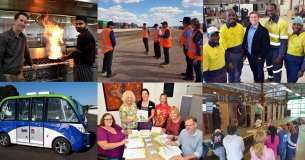 Latest News
Latest News
